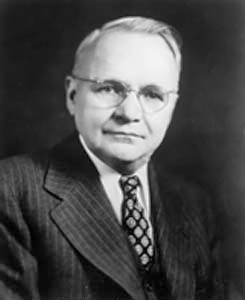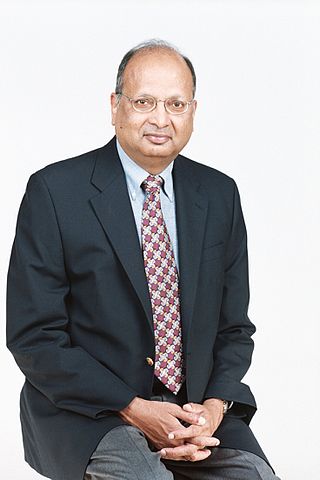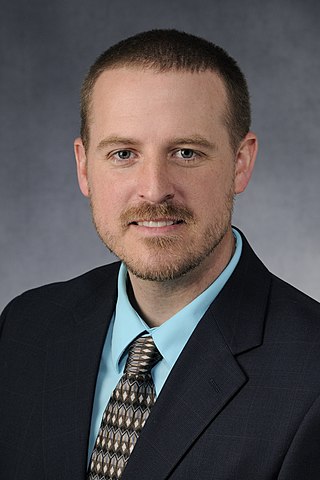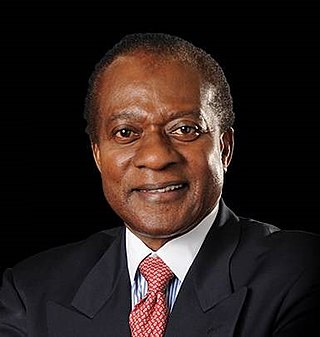Related Research Articles

Bell Labs is an American industrial research and scientific development company. Researchers from there are credited with the development of radio astronomy, the transistor, the laser, the photovoltaic cell, the charge-coupled device (CCD), information theory, the Unix operating system, and the programming languages B, C, C++, S, SNOBOL, AWK, AMPL, and others. Ten Nobel Prizes and five Turing Awards have been awarded for work completed at Bell Laboratories.

Harry Nyquist was a Swedish-American physicist and electronic engineer who made important contributions to communication theory.

John Robinson Pierce, was an American engineer and author. He did extensive work concerning radio communication, microwave technology, computer music, psychoacoustics, and science fiction. Additionally to his professional career he wrote science fiction for many years using the names John Pierce, John R. Pierce, and J. J. Coupling. Born in Des Moines, Iowa, he earned his PhD from Caltech, and died in Sunnyvale, California, from complications of Parkinson's Disease.

Kornelis Antonie "Kees" Schouhamer Immink is a Dutch engineer, inventor, and entrepreneur, who pioneered and advanced the era of digital audio, video, and data recording, including popular digital media such as compact disc (CD), DVD and Blu-ray disc. He has been a prolific and influential engineer, who holds more than 1100 U.S. and international patents. A large portion of the commonly used audio and video playback and recording devices use technologies based on his work. His contributions to coding systems assisted the digital video and audio revolution, by enabling reliable data storage at information densities previously unattainable.

Gerard Joseph Foschini, was an American telecommunications engineer who worked for Bell Laboratories from 1961 until his retirement. He died in September 2023. His research has covered many kinds of data communications, particularly wireless communications and optical communications. Foschini has also worked on point-to-point systems and networks.
Arun N. Netravali is an Indian–American computer engineer credited with contributions in digital technology including HDTV. He conducted research in digital compression, signal processing and other fields. Netravali was the ninth President of Bell Laboratories and has served as Lucent's Chief Technology Officer and Chief Network Architect. He received his undergraduate degree from IIT Bombay, India, and an M.S. and a Ph.D. from Rice University in Houston, Texas, all in electrical engineering. Several global universities, including the Ecole Polytechnique Federale in Lausanne, Switzerland, have honored him with honorary doctorates.

Arogyaswami J. Paulraj is an Indian-American electrical engineer, academic. He is a Professor Emeritus in the Dept. of Elect. Engg. at Stanford University.
Dr. Harold Allen Rosen was an American electrical engineer, known as "the father of the geostationary satellite", and "father of the communications satellite".
Stewart David Personick is an American researcher in telecommunications and computer networking. He worked at Bell Labs, TRW, and Bellcore, researching optical fiber receiver design, propagation in multi-mode optical fibers, time-domain reflectometry, and the end-to-end modeling of fiber-optic communication systems.
Krishan Sabnani is an Indian-American networking researcher. He has made many seminal contributions to the Internet infrastructure design, protocol design, and wireless networks. Krishan made a breakthrough in Internet re-design. The main idea behind this work was to separate control functions and complex software from the forwarding portions on Internet routers. This work made it possible for forwarding technologies to evolve and be deployed independently from control protocols. This contribution is a precursor to the current Software Defined Networking (SDN) revolution. A patent based on this work won the 2010 Edison Patent Award.
Ian Munro Ross FREng was an early pioneer in transistors, and for 12 years President of Bell Labs.

Asad Ali Abidi is a Pakistani-American electrical engineer. He serves as a tenured professor at University of California, Los Angeles, and is the inaugural holder of the Abdus Salam Chair at the Lahore University of Management Sciences (LUMS). He is best known for pioneering RF CMOS technology during the late 1980s to early 1990s. As of 2008, the radio transceivers in all wireless networking devices and modern mobile phones are mass-produced as RF CMOS devices.
Barrie Gilbert was an English-American electrical engineer. He was well known for his invention of numerous analog circuit concepts, holding over 100 patents worldwide, and for the discovery of the Translinear Principle. His name is attributed to a class of related topologies loosely referred to as the Gilbert cell, one of which is a mixer - a key frequency translation device - used in every modern wireless communication device. A similar topology, for use as a synchronous demodulator, was invented by Howard Jones in 1963.
Zhang Hongjiang is a Chinese computer scientist and executive. He was CEO of Kingsoft, managing director of Microsoft Advanced Technology Center (ATC) and chief technology officer (CTO) of Microsoft China Research and Development Group (CRD). Hongjiang is currently Chairman of BAAI. In 2022, he was elected to the National Academy of Engineering for his technical contributions and leadership in the area of multimedia computing.
Jesse Eugene Russell is an American inventor. He was trained as an electrical engineer at Tennessee State University and Stanford University, and worked in the field of wireless communication for over 20 years. He holds patents and continues to invent and innovate in the emerging area of next generation broadband wireless networks, technologies and services, often referred to as 4G. Russell was inducted into the US National Academy of Engineering for his contributions to the field of wireless communication. He pioneered the field of digital cellular communication in the 1980s through the use of high power linear amplification and low bit rate voice encoding technologies and received a patent in 1992 for his work in the area of digital cellular base station design.

John Mathew Cioffi is an American electrical engineer, educator and inventor who has made contributions in telecommunication system theory, specifically in coding theory and information theory. Best known as "the father of DSL," Cioffi's pioneering research was instrumental in making digital subscriber line (DSL) technology practical and has led to over 400 publications and more than 100 pending or issued patents, many of which are licensed.

Shannon D. Blunt is an American radar engineer and the Roy A. Roberts Distinguished Professor of Electrical Engineering & Computer Science at the University of Kansas (KU) in Lawrence, KS. He is Director of the KU Radar Systems & Remote Sensing Lab (RSL) and the Kansas Applied Research Lab (KARL).
Nambirajan Seshadri is a professor of practice at the Department of Electrical and Computer Engineering, Jacobs School of Engineering, University of California, San Diego.

Victor B. Lawrence is a Ghanaian-American engineer credited with seminal contributions in digital signal processing for multimedia communications. During his 30-plus-year tenure at Bell Laboratories, Dr. Lawrence made extensive and fundamental personal contributions to voice, data, audio and video communications. He led numerous projects that significantly improved or enhanced every phase in the evolution of early low-speed and today's high-speed data communications. He is a Research Professor and Director of the Center for Intelligent Networked Systems (iNetS) at Stevens Institute of Technology, where he also served as Associate Dean. He was inducted into the National Inventors Hall of Fame in 2016. He is a Member of the National Academy of Engineering, a Fellow of the IEEE for contributions to the understanding of quantization effects in digital signal processors and the applications of digital signal processing to data communications, a Fellow of AT&T Bell Labs, and a Charter Fellow of the National Academy of Inventors.
James H. Mulligan Jr. was an American electrical engineer and professor. He was dean and professor emeritus of electrical and computer engineering of University of California, Irvine and former secretary and executive officer of the National Academy of Engineering.
References
- 1 2 NAE Website - Dr. Jack M. Sipress
- 1 2 3 IEEE Membership Directory - Vol. 1-2 Institute of Electrical and Electronics Engineers., 2001. p. 398
- ↑ Electronics, Vol. 41 McGraw-Hill Publishing Company, 1968. p. 85.
- 1 2 Jack Sipress Global History Network
- ↑ Sipress, Jack M. "CAPACITANCE." U.S. Patent No. 2,998,580. 29 Aug. 1961.
- ↑ Sipress, Jack M. "SIPRESS." U.S. Patent No. 3,098,978. 23 Jul. 1963.
- ↑ Sipress, Jack M. "CO O CO." U.S. Patent No. 3,302,193. 31 Jan. 1967.
- ↑ Sipress, Jack M. "Error detection in paired selected ternary code trains." U.S. Patent No. 3,418,631. 24 Dec. 1968.
- ↑ NEC Research & Development Vol. 32-33 (1991). p. 128
- ↑ InTech. Vol. 42. (1995) p. 20